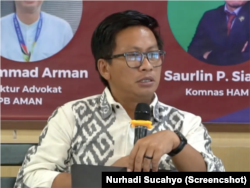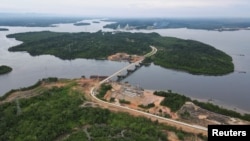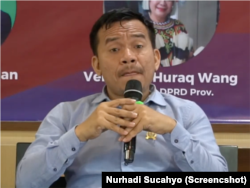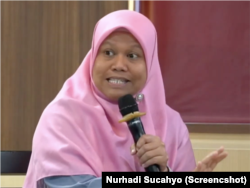One of the tribes that has lived in the IKN core area for hundreds of years is the Balik tribe. Administratively they now live in Sepaku sub-district. Sibukdin, the traditional head of the Balik tribe in the sub-district, said that until now Not yet There is confession valid law, related their existence and rights in IKN.
“We hope that we can find a solution, so that we can get recognition from the government specifically for those of us who are there. “It’s impossible for us to be there, people from outside brought us in, we were the ones kicked out of there,” he said.
Sibukdin conveyed this in a discussion regarding the existence of indigenous communities in IKN, which was held at Mulawarman University, Samarinda, East Kalimantan, Thursday (6/7). The discussion was held by the Center for Women and Children’s Legal Studies (PuSHPA), Faculty of Law, Mulawarman University, and Alliance of Indigenous Peoples of the Archipelago (AMAN).
“We can’t possibly refuse. It is considered that the language will be less pleasant. But we cannot yet fully accept or support the existence of IKN in our place. “To be honest, because our existence has not been recognized,” he added.
Development of the IKN area itself continues to this day. Data from the Ministry of Public Works and Public Housing (PUPR) states that the progress of phase 1 development has reached around 30 percent.
Muhammad Arman, Director of Advocacy at PB AMAN, said that in the midst of the IKN infrastructure project, there were many problems concerning indigenous communities that not finished yet.
“Zero Point marks the beginning of a situation faced by indigenous peoples for a long time. After the expansion of extractive industries, there were mines, one of them, then Industrial Plantation Forests (HTI). “Point Zero marks the beginning of a process of eliminating indigenous peoples,” said Arman.
The Zero Point that Arman mentioned is the central location of IKN, which has been the venue for ceremonial events related to IKN.
Arman reminded, in context IKN, academic manuscript which is the basis for preparing the Draft Constitution (RUU) IKN clearly mentions the existence of indigenous communities. There is seven the indigenous tribes mentioned in the academic text.
“But once translated into the Draft Law, No there it is, he’s gone. So academic manuscripts as quality control “from one bill it loses value,” said Arman.
Not only that, in its implementation in the field, the IKN development process is also without participation of indigenous communities. In fact, said Arman, they must be talked to in the context of what is known as participation full and effective. This process regulated in various legal instruments.
“Secondly, the community was never given the opportunity from the start to say, I agree or I disagree. “You can build here, this can be built here, this can’t be built there,” explained Arman.
“The government seems to assume that the land where the IKN will be built is empty land with no owner’s land,” continued Arman. However, it’s based indicative map compiled by AMAN last year, there were 51 indigenous communities that would be affected by IKN. As much 17 communities there are in Penajam Paser Utara and 34 community in Kutai Kartanegara.
The IKN Law Needs to Be Revised
Various problems involving indigenous communities must be resolved fundamentally. For this reason, the commissioner of Komnas HAM, Saurlin P. Siagian, firmly requested a revision of the IKN Law, as a legal basis for development.
“Indeed, we recommend that the IKN Law be revised. “So, I think it is still very relevant, Komnas HAM recommends that the IKN Law be revised,” said Saurlin.
Saurlin agrees that the government should not treat the IKN area as empty land when development is carried out.
“There are traditional features there, there are past traditional areas, there are various types of Indonesian riches, there are various foods there,” said Saurlin.
Therefore, what must be thought about is how the community will welcome those who come because of the IKN development. However, in general, the government has not placed indigenous peoples in the position they should be.
In 2014-2016 Komnas HAM conducted national research regarding indigenous communities. The result is a book with a total of almost 4 thousand pages, containing recommendations and recognition for indigenous communities, including those in Kalimantan. Unfortunately, since the completion of the report, not many recommendations have been implemented by the government.
“Essentially, indigenous communities are still experiencing the problem of neglect. Not yet acknowledged. “Then when it is not recognized as a subject, as a community, as a society, that has the implication of not being recognized as ownership, territory or forest,” stressed Saurlin.
Komnas HAM noted, there are more than 2,500 communities custom throughout Indonesia Which needs recognition from the country.
Legal expert from Mulawarman University, Rahmawati Al Hidayah, sees a different point of view on this issue. From the side public custom, there is unrest because they feel intimidated, there is no commitment to recognition, and there is no access to information yet. But the government on the other hand insists that the whole process IKN development, stated in master plan which already contains comprehensive data including about mastery the land.
“What did we find? Local communities exist, indigenous communities exist. “However, the current formal legal situation places indigenous communities in a weak position, especially in the context of land,” said Rahmawati.
Data from the Ministry of Public Works and Public Housing (PUPR) as of last June, construction progress in IKN phase 1 reached 29.45 percent. The entire IKN phase 1 project is targeted for completion in 2024, especially as President Joko Widodo requested that the 2024 independence commemoration ceremony be held at IKN.
All projects at IKN from 2022-2024 are divided into 76 work packages, with 37 currently under construction. A total of 76 packages is estimated to cost IDR 62.27 trillion. (ns/ab)









